The Microsoft Surface Pro 6 Review: More Than A Color
by Brett Howse on October 16, 2018 3:01 AM EST- Posted in
- Laptops
- Microsoft
- Surface
- Tablets
- Surface Pro
- Surface Pro 6
Display Analysis
Microsoft has gotten serious about display quality since the Surface 3 launched – and not the Surface Pro 3, but smaller, cheaper Surface 3. That was when they started to individually calibrate all displays on all devices, and the difference was dramatic. The average grayscale error level on the Surface Pro 3 was 6.4, with the display shifted to blue fairly dramatically, but the Surface 3 was 2.49. Since then, the company has refined their calibration, and at this point they are the only PC maker other than Apple to calibrate the displays on every product in their lineup. As such, Surface devices tend to have excellent color reproduction.
But a display isn’t just about accuracy. You also need a resolution that is high enough that you can’t really make out the individual pixels, and Microsoft has kept the same 267 pixels per inch with their 2736x1824 12.3-inch panel as the previous two generations. For most people, that’s high enough where going higher would just impact battery life for no reason.
Another key feature is contrast ratio, and here the Surface Pro series was lagging somewhat compared to the best in the industry, which includes the Surface Book which offers exceptional contrast. We’ll test that with the 2018 model and see if it’s improved.
Microsoft has also stuck with the sRGB panel in the Surface Pro 6, with the same “enhanced sRGB” mode available in the Windows 10 Action Center. To quote Microsoft on the matter:
“The Enhanced setting on the New Surface Pro is a profile within the sRGB space where through special hardware and proprietary color processing we take the mid-tones as close to P3-D65 color gamut as possible while leaving skin tones as is. The overall color contrast is also enhanced.”
So the skin tones are unaffected but other colors are made more vivid. Although the Surface Pro series is generally incredibly accurate, running in a pure sRGB mode can feel a bit dull to some customers, so those customers can leverage the enhanced mode for a less accurate, but more punchy color scheme. Those that need or want sRGB can have it with the tap of a button. It’s a good compromise since they’ve stuck with the sRGB panel again this year.
Microsoft wants to showcase their platform with Surface, and on a device like Surface Studio they’ve done that, offering sRGB, P3 D65, and DCI-P3 gamut support, but with the move to HDR as well as wider color gamuts, it was disappointing to not see any of the Surface lineup offer HDR support. Perhaps the Surface Pro isn’t the right vehicle for this though, due to the power requirements of HDR impacting battery life, but if Microsoft is going to continue to push technology in the Surface series, it’s something we should be expecting soon.
To test the Surface Pro 6 display, we use SpectraCal’s CalMAN software suite, along with an X-Rite i1Display Pro colorimeter for brightness and contrast readings, and the X-Rite i1Pro 2 spectrophotometer for color accuracy testing.
Brightness and Contrast
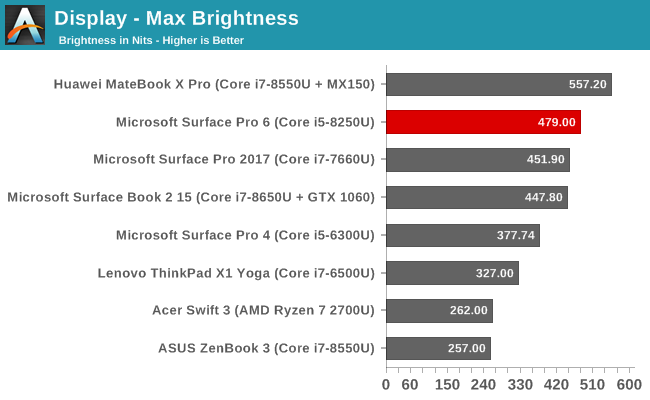
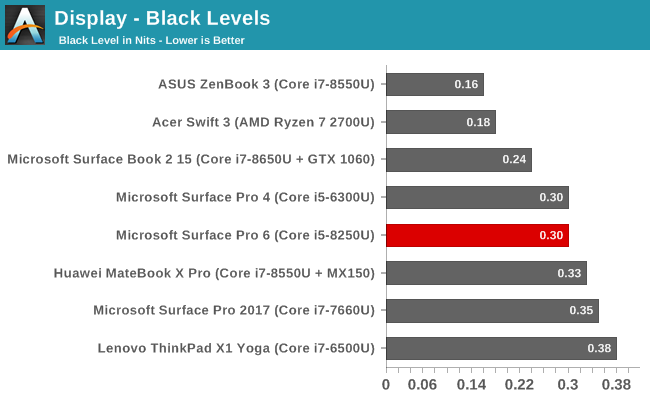
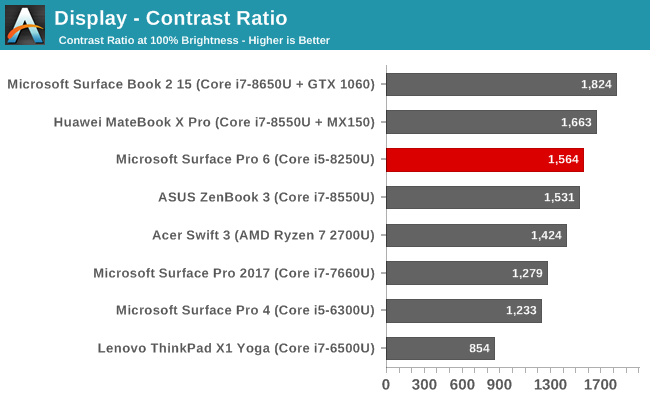
The Surface Pro 6 does improve overall peak brightness somewhat compared to the previous model, but the big improvement is the black level, which is significantly better on the latest Surface Pro, bumping the contrast ratio up to over 1500:1. The difference may not seem like a lot compared to the outgoing model, but the improved contrast was immediately noticeable when powering on the new device. This was probably achieved by using better aligned panels in the new display. It still can’t quite match the Surface Book 2, but it’s much closer.
Mininum brightness is 5 nits.
Grayscale Accuracy
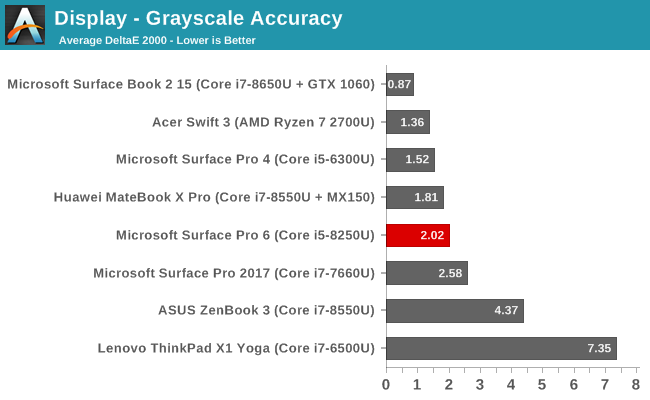
Every review unit is always going to be a bit of a lottery, although hardware calibration at the factory will fix most of the display issues. The grayscale accuracy of the Surface Book 2 we reviewed earlier this year was a stunning 0.87, but the new Pro 6 can’t quite match that, although with a dE2000 well under 3 across most of the range, it would still be considered one of the most accurate displays around. Gamma isn’t exactly at the 2.2 expected though, and the blue levels do drop off a bit as you close in on 100% brightness.
Gamut Accuracy
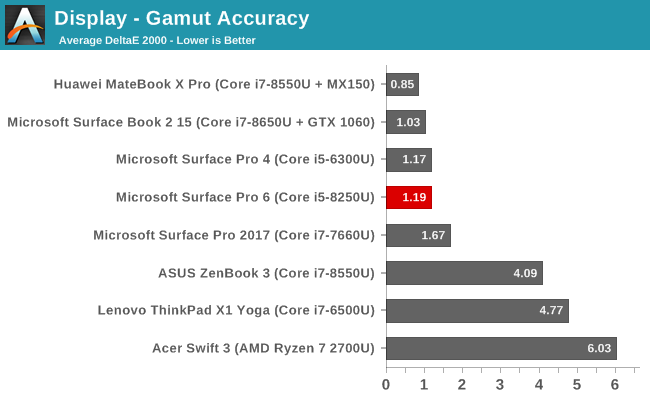
The gamut test checks the 100% levels for all of the primary colors (red, green, and blue) as well as the secondary colors (cyan, magenta, and yellow) and as usual a lower error level means that the display is closer to what it is supposed to be displaying. The Surface Pro 6 comes in with a stellar 1.19 average error level, which is practically imperceptible. At 100% blue, the blue levels are a bit lower than they should be, which is something we saw in the grayscale as well.
Saturation Accuracy

Our saturation sweep tests 4-bit steps across the entire range of primary and secondary colors, and other than the 100% blue levels we had already seen in the other tests, the saturation is almost perfect with an average error level just over 1.0.
Gretag Macbeth
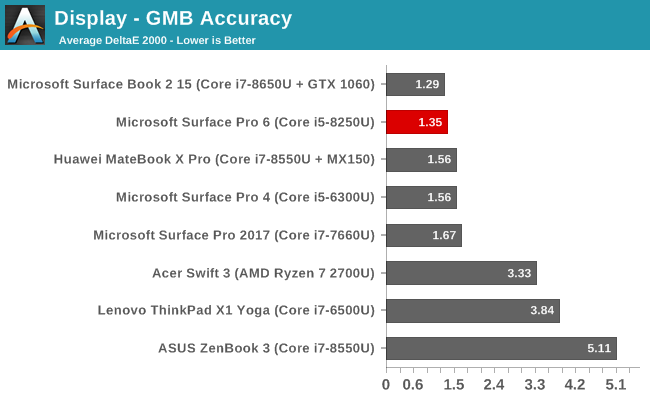
The Gretag Macbeth colorchecker tests not only the primary and secondary colors, but also a wide range other points including the important skin tones. None of the tested colors showed an error level over 3.0, which is excellent, and the overall average error level was just 1.35.
This relative colorchecker shows you the Surface Pro 6 displayed colors on the top, compared to the expected colors on the bottom, and as you can see the display is more or less perfect.
Display Conclusion
We often harp on the power of individually calibrating displays, and this Surface Pro 6 review model is an ideal candidate to discuss why. Here we have a display that shows more or less ideal reproduction of almost all colors, but the display can’t quite hit the full 100% level for sRGB blue. Rather than using an icc profile to correct this, which would likely cause crushing and banding, the entire range of blue is corrected to the best it can be, but 100% blue and just under is a bit off. You can’t use calibration to make a display show more color gamut than it’s capable of, and this Surface Pro 6 unit can’t quite hit 100% blue, but thanks to the calibration, that deficiency is almost imperceptible to the eye.
It would be nice to see Microsoft embrace HDR on Surface Pro in a future model, but the power costs would be high enough that the drop in battery life would likely be disliked by many of their customers.
Overall, as we’ve come to expect with all Surface devices, the display on the Surface Pro 6 is one of the best around, with accurate colors, high resolution, and now, even better contrast.


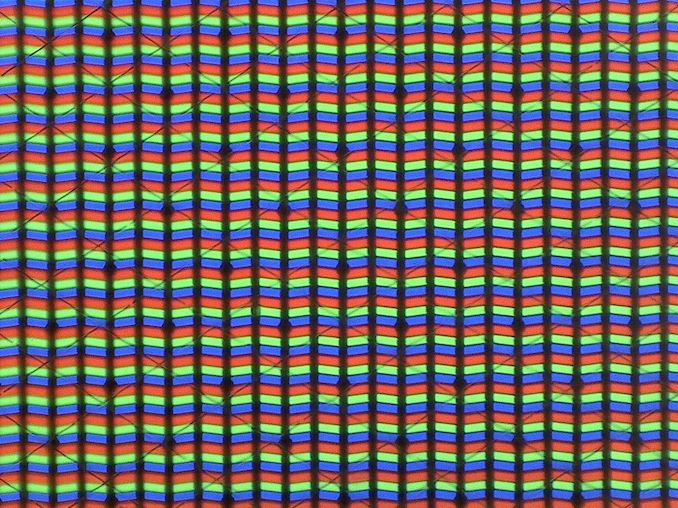













80 Comments
View All Comments
cfenton - Monday, November 5, 2018 - link
This is just non-sense. I have a 5 year old Macbook Pro I use almost everyday and its battery is fine. I'm sure some will die in 3 years, but most will run just fine for much longer.star-affinity - Wednesday, October 17, 2018 - link
I think it looks great. Some aspects of Windows 10 looks pretty decent too. Too bad a lot of third party Windows software seems made by people who seemingly have little sense of graphic/user interface design an seems stuck with a Windows 95-ish look for their apps.Frenetic Pony - Wednesday, October 17, 2018 - link
"the display on the Surface Pro 6 is one of the best around, with accurate colors, high resolution, and now, even better contrast."The hell it is, the Ipad Pro has had a brighter, higher contrast, HDR display since last year AND has great battery life. My phone has a brighter, higher contrast, better calibrated, HDR display than this has. Lenovo has HDR screens on laptops that work fine, and have a higher PPI to boot. Microsoft is driving around competing for an entire division lower than "best tech possible" and charging a thousand+ dollars for it.
This entire device is pathetic, Whiskey Lake has a USB 3.1 controller built in but MS has deliberately downgraded it, probably just to make it's NEXT Surface seem like a better upgrade. Where's the Thunderboldt 3 ports MS? Intel dropped the licensing, even AMD laptops include it. Calling this device anything other than a deliberately crippled second tier device MS doesn't care about is a journalistic disservice.
Mitch89 - Wednesday, October 17, 2018 - link
"Other than Apple, Microsoft is the only company that controls both the hardware and software sides, and when the Surface lineup launched way back in 2012, Microsoft’s goal was to showcase the advantages of their platform with a premium hardware lineup. "I'm curious what things you think Microsoft have done to take advantage of this in 2018?
domboy - Friday, October 26, 2018 - link
Now if they'd just release a new ARM-based Surface with all these same improvements...c.economides - Saturday, October 27, 2018 - link
Can you please let us know which software you use to measure the thermal performance in this review?If it's proprietary are you able to share it with us?
Thank you.
c.economides - Saturday, October 27, 2018 - link
I am asking because my i5 Surface Pro 6 reproduces the results from all other benchmarks you have run on your test unit, but using prime95 or the powermax stress test, I absolutely havent to replicate your thermals.When all cores are testes (8 threads) the clock stabilizes at 2.4GHz and is a far way from the 2.9GHz you mention. The way I can replicate your results almost 1:1, is if I set the test to 2 threads, then I get a stable power draw of 18W with an average clock of 2.9GHz
albert89 - Saturday, November 10, 2018 - link
Would love to see the same laptop with AMD's APU pro series installed.I have no doubt they can more than match CPU & GPU output at a lower price.
Not that anyone is interested in high performance, low cost laptops these days.
dehwei - Monday, May 13, 2019 - link
When running the battery tests what was the brightness set to? (ie. 40%) It's hard for us to translate nits to windows brightness control. Also was the keyboard attached and was the video playback with audio? If so, what was the volume set to? I am trying to recreate the video playback test with my surface.qiechai - Friday, June 12, 2020 - link
I'm a digital artist . I have a Surface Pro and I use it for drawing in Illustrator and like it a lot! Definitely do not regret the purchase, it saves me hours in terms of workflow. but the pen experience is not as good as the professional drawing tablet . I have a XP-Pen Artist 24 Pro drawing tablet with screen 24" . The pressure on my XP-Pen Artist 24 Pro screen drawing tablet is lighter and smoother especially at the low end, giving better, more natural marks. The Surface is usable, but is a bit of a compromise compared to the Artist 24 Pro . If you are looking for the best pen experience go with the professional graphic tablet.